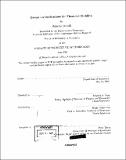| dc.contributor.advisor | Stephen A. Ross and Bengt Holmström. | en_US |
| dc.contributor.author | Benelli, Roberto, 1971- | en_US |
| dc.contributor.other | Massachusetts Institute of Technology. Dept. of Economics. | en_US |
| dc.date.accessioned | 2005-08-23T19:56:37Z | |
| dc.date.available | 2005-08-23T19:56:37Z | |
| dc.date.copyright | 2002 | en_US |
| dc.date.issued | 2002 | en_US |
| dc.identifier.uri | http://hdl.handle.net/1721.1/8406 | |
| dc.description | Thesis (Ph.D.)--Massachusetts Institute of Technology, Dept. of Economics, 2002. | en_US |
| dc.description | Includes bibliographical references (p. 150-155). | en_US |
| dc.description.abstract | This thesis includes three essays on the interaction between financial market institutions and market liquidity, and its implications for financial stability. The first essay studies an overlapping generations model of a risky asset market in which some agents face a participation cost. Market participation, by affecting the size of the pool of potential holders of the risky asset, determines the liquidity of the asset market. This essay studies how the frictions that are associated with capital requirements on financial institutions affect their incentives to supply liquidity to the market. The participation decision generates a positive and a negative externality, and the interaction between the two externalities can give rise to multiple equilibria in participation, i.e. to "liquidity cycles". The second essay studies the complementary problem of the optimal design of incentive systems for financial institutions in the context of limited market liquidity. In a contract between a borrower and a lender, financial incentives are provided by requiring the borrower to finance a sufficiently large share of her investment project. In the states of nature in which many projects are liquidated simultaneously, liquidation in private contracts is excessive relative to the efficient (second-best) contract chosen by a planner who internalizes the externality working through the liquidation price. This essay studies whether capital requirements on the borrowers can implement the second best allocation, and if not what kind of policy instruments can implement it. | en_US |
| dc.description.abstract | (cont.) The last essay presents a model of international lending that is built on a basic form of contractual incompleteness: foreign investors cannot commit to provide state-contingent or long-term finance to domestic entrepreneurs. This form of contractual incompleteness implies that there is excessive liquidation of socially viable projects in the competitive equilibrium that emerges in decentralized markets. Institutions that manage to limit liquidation have the potential to improve welfare. | en_US |
| dc.description.statementofresponsibility | by Roberto Benelli. | en_US |
| dc.format.extent | 155 p. | en_US |
| dc.format.extent | 11335614 bytes | |
| dc.format.extent | 11335371 bytes | |
| dc.format.mimetype | application/pdf | |
| dc.format.mimetype | application/pdf | |
| dc.language.iso | eng | en_US |
| dc.publisher | Massachusetts Institute of Technology | en_US |
| dc.rights | M.I.T. theses are protected by copyright. They may be viewed from this source for any purpose, but reproduction or distribution in any format is prohibited without written permission. See provided URL for inquiries about permission. | en_US |
| dc.rights.uri | http://dspace.mit.edu/handle/1721.1/7582 | |
| dc.subject | Economics. | en_US |
| dc.title | Essays on institutions for financial stability | en_US |
| dc.type | Thesis | en_US |
| dc.description.degree | Ph.D. | en_US |
| dc.contributor.department | Massachusetts Institute of Technology. Department of Economics | |
| dc.identifier.oclc | 50600730 | en_US |
